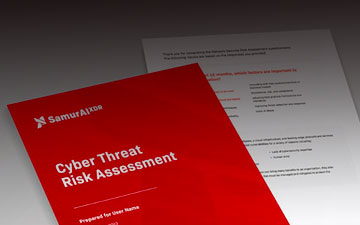Every year, new cybersecurity threats arise that need to be tackled. However, few have been as unnerving and challenging to address as deep fakes. Most of us are familiar with the viral Tom Cruise deep fake, which was created by a VFX artist to show what this technology is capable of today.
As time goes on, there's a good chance that deep fakes will only become more convincing. That's why, in this post, we're going to be looking at the basics of deep fakes, from what they are to how you can protect yourself against them.
What is a deep fake?
To start, let's cover what a deep fake is for those that might not be aware. Generally speaking, a deep fake is a video that has been doctored to create the appearance of someone who isn’t actually there.
For example, you or I could use a deep fake to make it look like we are a famous celebrity, a political figure, or even a coworker. Typically, the victim's voice, mannerisms, hair, and so on will need to be imitated by the person in the video, which is why lookalikes are often used as a starting point for a deep fake.
That said, with the way that technology is evolving, it may soon be possible to imitate and recreate voices and mannerisms using software as well.
How do deep fakes work?
While no two deep fakes are created exactly the same way, most deep fake videos start by compiling a large amount of footage of the victim and passing it through a machine learning network. That network then develops a 3D rendering of the victim's face from this footage.
Then, the 3D face is mapped onto a video of the actor pretending to be the victim. The mapping follows the actor's facial movements and expressions so that it looks like it's the victim speaking and not the actor.
The risks of deep fake visuals
While the person behind that famous Tom Cruise deep fake had no malicious intention, businesses and individuals would be right to be concerned about how this technology can be used. In the wrong hands, deep fakes can be utilized for a range of fraudulent and criminal endeavors.
Scams and hoaxes
If the Tom Cruise deep fake video had not been clearly labeled as a fake, there's a good chance that it could've gone viral and passed through thousands if not millions of eyes without being realized for what it really is.
The actor in the video could've used this as an opportunity to say and do things that would harm Tom Cruise's reputation, making it difficult for the celebrity to later undo the damage.
The same thing could be accomplished by imitating important public figures and otherwise faking video evidence of an event that hasn't actually happened.
An example of this is the deepfake was a video of Ukraine’s president Zelensky telling Ukrainians to surrender, which surfaced in March this year, shortly after the beginning of Russia’s invasion of Ukraine.
Social engineering
Another risk that deep fakes pose is in social engineering. While this is less likely to go viral and affect someone's reputation, it can be used to acquire information from unsuspecting victims.
For example, say you receive a video of your employer asking for sensitive financial information related to your business. You turn this information over, only to later realize that the video was a deep fake.
As unrealistic as it may sound, this social engineering scam has already been successfully accomplished before. The CEO of a U.K.-based energy firm was persuaded into transferring €220,000 to what they thought was a supplier's bank account. In fact, it was a fraudster's account, which led to the theft of those funds.
Identity theft and financial fraud
Speaking of theft of funds, this is another serious and key risk of deep fake videos. Deep fakes can be used to create new identities or even to steal the existing identities of others. This would allow people to more easily commit financial fraud through stealing individuals' identities.
Identity theft and financial fraud are already key concerns for businesses across industries. Deep fakes serve as an extra threat, making these attempts at fraud that much more convincing.
Fraudsters could use deep fake technology to create inauthentic documents or accounts, complete purchases, and otherwise complete tasks that should only be possible by an authentic person.
How to spot a deep fake
While new tools and technologies are being developed to aid in the detection of deep fake videos, one of the best tools we currently have at our disposal is our own skepticism.
When watching a video in which the subject matter seems out of place, out of character, or otherwise suspicious, you can look for irregular details like:
- Unnatural eye movement and/or lack of blinking
- Unnatural facial expressions
- Unnatural body shape
- Unnatural hair or skin color/texture
Although these techniques aren't foolproof, they're a good start for identifying deep fake videos.
Deep fake fraud protection techniques
Use anti-fake technology
As well as skepticism, you can also deploy anti-fake tools to weed out deep fake videos.
In essence, these solutions are looking for artifacts that show the video or photo might not be real. This includes looking for the same sorts of details we just mentioned (unnatural movements, shapes, or expressions) but with a computer instead of the human eye.
Training and awareness
Another great way to prevent your business from being impacted by deep fake fraud is by implementing training and awareness on the subject. Many of your staff members might not know what a deep fake is, much less be aware of how to spot one.
Training is a great way to keep your team on guard and prepared to identify an incoming deep fake attempt.
Awareness is one of our best defenses. We always need to question the material we are presented with, and if we see media that purports to show someone saying something unusual we should be suspicious.
Robust security protocols
Lastly, implementing robust security protocols throughout your business can stop a deep fake in its tracks. As intimidating as a deep fake may seem, remember that it is just one step in successfully pulling off fraud successfully.
The more gateways, measures, and walls you put up in front of fraudsters, the less likely it is that a deep fake attempt will be successful.
Build your defense against emerging cyber threats
Deep fakes are just one of the newest threats facing businesses in our increasingly digital world. To better understand and protect against these concerns, you need the latest, greatest tools.
Samurai XDR utilizes AI and ML to increase your organization’s security posture. Firewalls produce telemetry that’s used to help detect advanced threats and our AI brings all of these sources together to provide a single, simple view of your security landscape. Your business is up against many cyber threats, but our tools help separate the signal from the noise.
To learn more about how Samurai XDR can protect your business, reach out to our team of experts today.
Featured articles
Identity Management in the Physical and Digital Worlds
7 August 2024 | Webinars
In today's rapidly evolving world, managing identities securely and efficiently is more crucial than ever. Join us for an insightful...
Identity Management in the Physical and Digital Worlds
30 July 2024 | Webinars
In today's rapidly evolving world, managing identities securely and efficiently is more crucial than ever. Join us for an insightful...
XDR for Small and Medium Businesses: Is It Worth It?
24 July 2024 | XDR
Cybersecurity is of paramount importance to virtually all organizations and SMBs have to address several specific challenges. The failure to...





